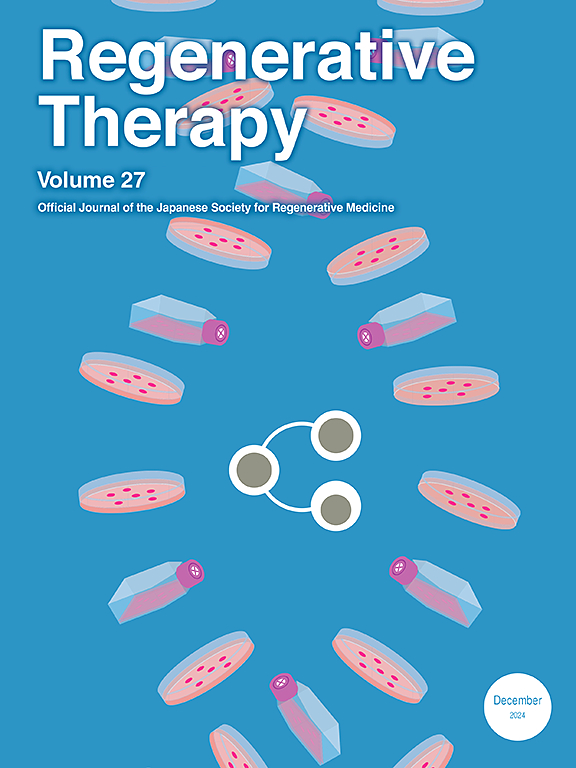MAPT-A152T突变通过人类ipsc衍生神经元中的fn - nmdar信号驱动神经元过度活跃:对阿尔茨海默病发病机制的见解
IF 3.4
3区 环境科学与生态学
Q3 CELL & TISSUE ENGINEERING
引用次数: 0
摘要
Tau蛋白在阿尔茨海默病(AD)的发病机制和调节神经元兴奋性中起着关键作用。在tau编码微管相关蛋白tau (MAPT)基因突变中,有报道称A152T突变可增加小鼠模型中AD和神经元兴奋性的风险。方法:为了研究MAPT基因表达及其突变对人类神经元神经元活性的影响,我们采用基因组编辑技术将A152T或P301S突变导入诱导多能干细胞(iPSCs)。然后将其分化为兴奋性神经元和抑制性神经元。作为对照,MAPT基因被荧光蛋白取代的iPSCs也被创造出来。结果:在兴奋性神经元培养中,发现A152T突变增强了自发神经元活动以及tau和Fyn的关联。然而,在抑制性神经元富集培养中,A152T突变不影响神经元活性。NMDA受体(NMDAR)的抑制和tau蛋白水平的降低降低了A152T/A152T和健康对照(WT/WT)兴奋性神经元的兴奋性。此外,A152T突变增加了tau和Fyn之间的相互作用。这些发现表明,在生理条件下,tau-Fyn相互作用在调节神经元活动中起着关键作用,而A152T突变通过加强tau和Fyn之间的内源性相互作用来增强神经元活动。此外,转录组学分析揭示了A152T突变的兴奋性神经元特有的结构变化。在A152T和P301S系中观察到的共同变化再现了去分化表型,与先前的报道一致。结论:这些数据表明,MAPT基因的A152T突变通过兴奋性神经元的tau-Fyn-NMDAR通路增加神经元的兴奋性,揭示了其在AD发病机制中的作用。本文章由计算机程序翻译,如有差异,请以英文原文为准。
MAPT-A152T mutation drives neuronal hyperactivity through Fyn-NMDAR signaling in human iPSC-Derived neurons: Insights into Alzheimer's pathogenesis
Introduction
Tau protein plays a pivotal role in the pathogenesis of Alzheimer's disease (AD) and in regulating neuronal excitability. Among tau-coding microtubule associated protein tau (MAPT) gene mutations, the A152T mutation is reported to increase the risk of AD and neuronal excitability in mouse models.
Methods
To investigate the effects of MAPT gene expression and its mutations on neuronal activity in human neurons, we employed genome editing technology to introduce the A152T or P301S mutations into induced pluripotent stem cells (iPSCs). We then differentiated them into excitatory and inhibitory neurons. As a control, iPSCs in which the MAPT gene was replaced with a fluorescent protein were also created.
Results
In excitatory neuronal cultures, the A152T mutation was found to enhance spontaneous neuronal activity and the association of tau and Fyn. However, in inhibitory neuron-enriched cultures, the A152T mutation did not affect neuronal activity. Inhibition of NMDA receptors (NMDAR) and the reduction of tau protein levels decreased neuronal excitability in both A152T/A152T and healthy control (WT/WT) excitatory neurons. In addition, the A152T mutation increased the interaction between tau and Fyn. These findings suggest that the tau-Fyn interaction plays a critical role in regulating neuronal activity under physiological conditions, while the A152T mutation enhances neuronal activity by strengthening this endogenous interaction between tau and Fyn. In addition, transcriptomic analysis revealed structural changes specific to excitatory neurons with the A152T mutation. Common changes observed in both A152T and P301S lines recapitulated a dedifferentiation phenotype, consistent with previous reports.
Conclusions
These data demonstrate that the A152T mutation in the MAPT gene increases neuronal excitability through the tau-Fyn-NMDAR pathway in excitatory neurons, shedding light on its role in AD pathogenesis.
求助全文
通过发布文献求助,成功后即可免费获取论文全文。
去求助
来源期刊

Regenerative Therapy
Engineering-Biomedical Engineering
CiteScore
6.00
自引率
2.30%
发文量
106
审稿时长
49 days
期刊介绍:
Regenerative Therapy is the official peer-reviewed online journal of the Japanese Society for Regenerative Medicine.
Regenerative Therapy is a multidisciplinary journal that publishes original articles and reviews of basic research, clinical translation, industrial development, and regulatory issues focusing on stem cell biology, tissue engineering, and regenerative medicine.
 求助内容:
求助内容: 应助结果提醒方式:
应助结果提醒方式:


